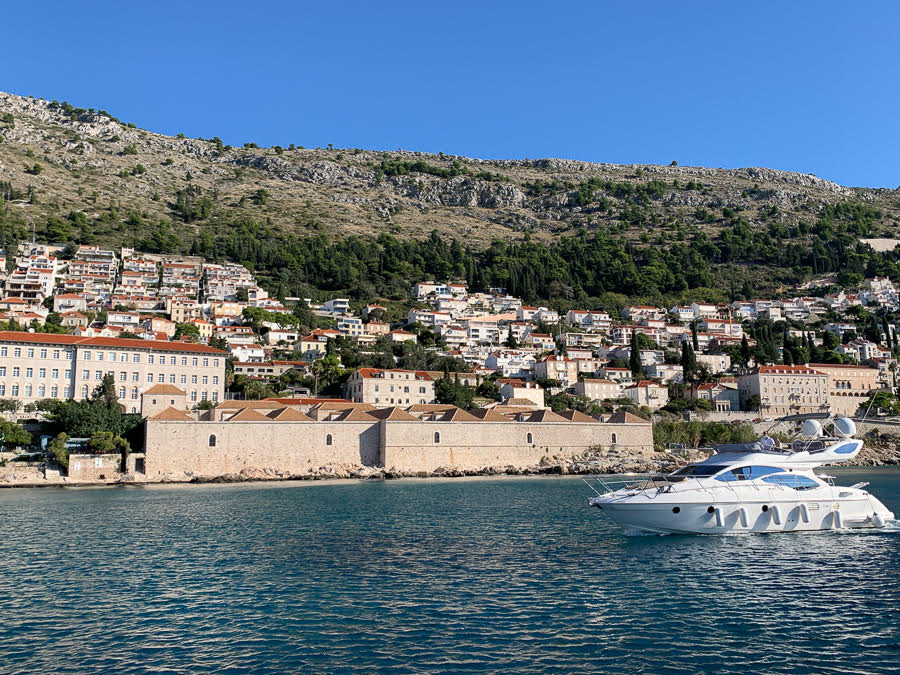October 28, 2020 - Freelancers Week may be over, but digital nomads are still making connections with one another and with coworking spaces, including the historic Lazareti in Dubrovnik.
My first experience with European Freelancers Week (#EFWeek2020), which just wrapped up, was a whirlwind from beginning to end. I worked in three different coworking spaces, learned how to open and operate an obrt, and socialized with a group of fellow “remote” females. From all this networking, a new project landed on my plate and began the same week. Awesome! The most memorable experience though was working on a kick-off event—the Dubrovnik for Digital Nomads conference.

(When epidemics spread rampantly in the 14th and 15th centuries, the Dubrovnik Republic took strict measures to organize sanitary and public healthcare services throughout the region. It’s no coincidence that epidemics of infectious diseases erupted and the period was characterized by a boom in trade.)
Independent work and workspace
Freelancers Week, the parent of #EFWeek, is a celebration of independent professionals and coworking spaces. The conference delivered on both, as a salute to Croatia’s impending digital nomad visa and with an offer of free coworking for the week. The event and the coworking were located in a place of historic consequence—Dubrovnik’s famed Lazareti. Ths row of buildings on the city’s waterfront is notorious as a former quarantine site. Hello, pandemic?

(Small windows in each courtyard were once doors where goods were unloaded from ships, directly into the lazaretto for holding.)
Quarantine origins
Poking around the buildings before the conference, I noticed an art exhibit on the walls. It was actually an illustrated account of the city’s quarantine origins. Dubrovnik was the first state in the world to institute an official quarantine system to protect its people against infectious diseases. “Our Lord God sent a terrible, unheard of judgment on the whole world…” The opening sentence of the prologue wasn’t exactly factual, but it got me wondering if the same God is in charge today, 600+ years after this story began. Don’t get me started…

(People who received a prison sentence for violating quarantine restrictions were held at Lovrjenac Fortress, just outside Dubrovnik’s city walls and the Pile Gate.)
Epidemics across the Mediterranean
Raging plague and cholera epidemics were common from the 14th to 18th centuries across Europe and Asia. During these Middle Ages, Dubrovnik was a thriving maritime Republic that received people and goods from all over the world. In 1348, the Black Death plague decimated the population and killed roughly one-third of its citizens. Although infectious diseases were largely attributed to poor hygiene and poor nutrition, treatments were ineffective. It was thought that isolating people who were infected would stop the spread. Three decades later, in 1377, the Republic announced quarantine measures. They targeted all travelers, merchants, sailors, and goods arriving from "suspicious lands." An isolation period of 40-days was mandated and only when a person was proven healthy would they be allowed into the city.

(In 1795, drummers in the Dubrovnik republic publicly announced that subjects in exile should return home and report to quarantine. The Republic would pay 4 dinarić (silver coins) for every day of quarantine. Whoever ignored this would be sentenced to death. If he tried to flee, a price would be put on his head of 100 sequins (Venetian gold coins).)
Lazarettos
The first lazarettos—quarantine stations, were built on remote, uninhabited islands just off the coast—Bobara, Cavtat, Mrkan, and Supetar. Over time, as others were constructed on different islands, including Lokrum, they became complex institutions. Scribes, guards, gravediggers, cleaners, priests, barbers, and healthcare officers were employed. The latter implemented quarantine restrictions and supervised compliance. Penalties for rule-breakers ranged from fines (100 ducats), to prison sentences, severe corporal punishment, and the threat of being shot. Seamen and their families received special dispensation. Since sailors typically had to return to sea immediately after their quarantine, wives and families were allowed to join them and quarantine together at the lazarettos.

(In cooperation with the Health Office, the Republic issued health certificates to confirm that passengers in Dubrovnik had undergone the prescribed quarantine, or to state there was no infection in the area at the time of their travel.)
Safety measures
Reading about various safety measures—from hundreds of years ago mind you, they were surprisingly familiar. There was contact tracing, decontamination of food and animals, disinfection of ships and buildings, self-isolation, lockdown, border closure, contactless payment, distance rules, prohibition of public gatherings, and more. Contact tracing in the 1600s? Yep. People reported who they had contact with and also what they saw and heard about others. They snitched! Supposedly, it worked, and the plague of 1691 was snuffed out in three months. Contactless payment? Yes, again. Place your ducats on the counter and the person on the other side swept them into a drawer with a stick.

(Buildings along the upper courtyard of the lazaretto were once holding facilities for travelers to quarantine before embarking. Today they house various businesses and artistic ventures.)
Lazareti
The Lazareti, located near the Ploče Gate, was completed in 1647. Its location is significant—situated next to Dubrovnik’s old port and the city’s main entry point. As my feet walked through this multi-story lazaretto, consisting of eight buildings and five interconnecting courtyards, I noticed the architecture that once sheltered people, goods, and caravans from afar. From the shared, upper courtyard at street level, large staircases lead to the individual, lower courtyards at sea level. From the top of each staircase you get an expansive view of the sea, the city walls, and the old town. Peering down, a single, barred window in each courtyard gives you a sweet view of the water. This creates a neat “picture in picture” visual effect yet, standing next to the window there’s an immediate awareness of being behind bars. You’re on the inside looking out.

(The lazarettos, consisting of eight buildings and five courtyards, were renovated in 1623 from the sea side in order to enable the landing of large boats. The complex included warehouses for goods and livestock and lodgings for the extended stay of merchants and travelers in isolation.)
Creative Quarter
Physically being in a place whose historic narrative of plagues parallels our current situation with covid-19 in many ways, gave me a surreal feeling of connection. It was a sense of “we’ve been here before, things will get better, I’m not alone.” It’s clever marketing to host a public event and a coworking space in a former isolation facility—during a pandemic no less! As a remote worker, I’m isolated every day at my home “office,” aka my kitchen table. This past week was a breath of fresh air, quite literally, at the Lazareti. I’m glad for European Freelancers Week and the opportunity to get new perspective.

(In the 17th century, Dubrovnik was the largest merchant transit center on the Adriatic and the lazarettos were one of the best organized quarantines in the Mediterranean.)
Story and photographs ©2020, Cyndie Burkhardt. www.photo-diaries.com.
You can follow the latest from Cyndie's column, Croatia Through the Eyes of a Digital Nomad here.

(From the upper courtyard, you get an expansive view of the harbor and the old town.)
For the latest news about digital nomads in Croatia, including that sought-after nomad visa, check out the dedicated TCN digital nomad news section.
Learn more about the Dubrovnik for Digital Nomads conference.

(A large lazaretto on Lokrum, under construction in 1534 was never finished but its remains are still visible. Benedictine monks planted an olive grove in the central courtyard.)


